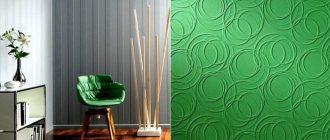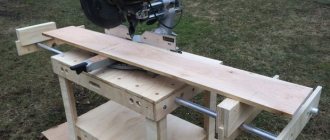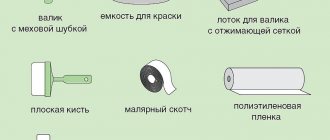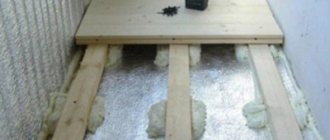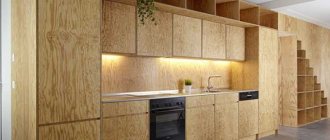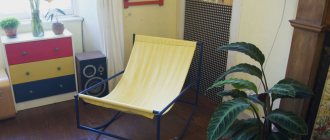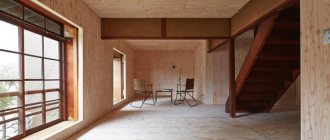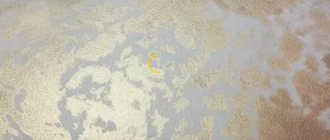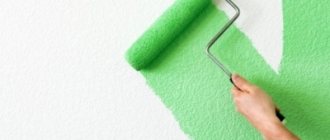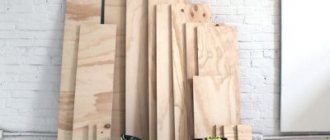Plywood is a very popular material that can be used for making furniture, as partitions in an apartment, or even for laying on the floor. Due to the fact that plywood is inexpensive and does not cause allergic reactions, it is very popular. Plywood can be easily painted. In this article we will look at the 3 best ways to paint plywood products.
One of the advantages of painting plywood is that it increases its wear resistance, that is, plywood on which paint is applied will last much longer.
Preparing for painting
The plywood preparation process takes place in several stages:
- Everyone knows the conditions in which plywood is stored in a warehouse, so when you buy plywood, it may be a little damp. The first step is to dry it completely. To do this, the plywood needs to lie in a dry room for about a day. This is a necessary condition before painting;
- The next step will be to clean the plywood surface from burrs and dust . First, its surface must be treated with sandpaper, and then treated with special sandpaper;
- The cleaned surface must be treated with a primer. This is necessary so that the plywood sheets do not change their shape. If a sheet of plywood is treated with a primer, then the paint will adhere to its surface in the best possible way;
Advice! After the primer has completely dried, it is best to treat the plywood sheet with antiseptics, this will prevent the appearance of fungus.
Processing plywood before painting
Before painting, plywood must be completely cleaned of dust and small sawdust. Plywood sheets should be painted along the wood grain.
Do not forget that before preparing plywood for painting and staining, the sheet must dry thoroughly. Everyone knows the property of this material - to warp. You can avoid the risk of deformation by simply keeping the sheets in a dry room at room temperature for 3-4 days. This is especially true if the material was stored on the street or in a damp construction warehouse. Experts recommend not neglecting this stage and keeping the material for several days in the room where you then plan to paint it.
Initially, the sheet must be sanded to remove any irregularities. This stage can only be avoided if you purchase high-grade material. It's already quite high quality. For cheap varieties, sanding is highly desirable.
First, use coarse-grained sandpaper (No. 80-100), and then use medium-grained sandpaper (No. 100-120). This improves the subsequent adhesion of the surface to the paint. Do not forget to process the edges of the sheets; if they are too rough, they can be lightly planed and then sanded.
If you need to hide joints, fasteners or very noticeable defects, use putty. This material will also be useful to you if you decide to glue wallpaper onto plywood. Don't forget to sand the putty areas
After grinding is completed, the surface must be primed; most often, drying oil, primers with an alkyd base, or special compounds that fill the pores of the material are used for this.
For large volumes of work, it is recommended to use electric grinders. They will save time, make work easier and improve its quality.
What is a primer used for?
If finishing with plywood sheets is done indoors, then due to fluctuations in temperature and humidity, the wood texture may change: shrink and expand. The primer as an intermediate layer will not allow the applied paint to crack and will protect the base from moisture penetration and the formation of fungus. The primer is applied with a roller.
It is necessary to allow the soil to dry, and then additionally treat the plywood with antiseptics and fire retardants, which will enhance protection against fire and prevent blue stains from appearing. This is one of the important elements of the preparation process if you are going to paint plywood with transparent paint that has low resistance to bioaggressive manifestations.
How to choose paint?
In order to decide on paint, you need to decide for yourself why the plywood will be painted, and under what conditions it will be exposed. For open spaces, paint with the addition of acrylic is best suited. This paint should be applied in two layers on each side of the plywood.
Facade paint is well suited for plywood, which contains glue with phenol-formaldehyde particles.
Water-based paint is well suited for plywood used in furniture making. Its advantages are that it has virtually no odor, dries quite quickly and is applied very well to the surface.
Choosing plywood for painting
Plywood production technology provides for the production of several categories of products:
- FC. This moisture-resistant material is used for making furniture and for interior decoration.
- FSF is a sample with increased moisture resistance, intended for roofing work. It is used where good wear resistance is required.
- Laminated (FOF) board has a special protective coating.
- Bakelite material with fiberglass reinforcing mesh
The nature of the staining depends on the degree of processing of the plywood and its grade.
There are 3 options for finishing sheets:
- NS – without grinding;
- Ш1 – with processing of 1 side;
- Ш2 – with grinding of both sides.
The grades reflect the external condition of the material, thereby determining the scale of preparatory work before painting.
Highlight:
- Elite (E) class plywood. It is distinguished by the absence of knots and other surface defects.
- I grade. Here, the presence of 5 knots up to 1.5 cm long per 1 square meter is allowed. m.
- Material of grades II and III has veneer inserts, scratches, and dents. Knots and marks from them may be visible, as well as glue residues on the edges. The presence of cracks up to 20 cm per 1 square meter is acceptable. m. The number of defects and their quality determines the grade of the samples.
- Grade IV may contain any types of flaws while maintaining the technical characteristics of the material.
Before painting plywood received from the warehouse, it is allowed to rest. If the temperature in the room coincides with the temperature regime of the storage, you can start working after 24 hours, if the difference is 2-8°C - after 3 days. If this difference is greater, then you need to wait a week.
Pay attention to: Protection of wooden windows: choice of paint and varnish material and painting technology
Painting process
There are several ways to paint plywood:
- Painting along the wood grain line . Paint is applied over the entire sheet in the same amount. The paint should be applied in a small layer. Applying paint in a large layer risks the formation of lumps, which can ruin the entire appearance of the plywood. After the first coat has dried, it is best to begin applying the next coat of paint.
- An alternative to paint can be varnish . Before varnishing, the surface of the plywood must be made smooth. Varnish, like paint, is coated in two layers. After the first coat has dried, it must be sanded and then a second coat must be applied.
Advice! When painting plywood, it is necessary to cover all pieces of furniture located next to the plywood with film.
- You can simply bleach the plywood. For this purpose, special products containing chlorine are used.
Plywood can be painted with acrylic or oil paint. Acrylic - has a fairly high cost and is not very safe. By following the advice in this article, you will definitely be able to paint plywood correctly, and you will be satisfied with your result.
REVIEW of paints and varnishes for plywood (1 video)
Paint selection
When deciding what to paint plywood with, it is important to keep in mind the expectations of the final result. You can simply do the staining. It will allow you to change the color of the veneer, make it darker, deeper and leave it that way. The procedure allows you to achieve the effect of using valuable wood species. Wood stain is an excellent antiseptic. It gives the base a matte look.
You can then varnish the stained surface. It will acquire a pleasant gloss. When interior design requires preserving the natural look of wood veneer, plywood products are simply varnished. In this design, the material looks noble.
If there is a need to completely hide the nature of the origin of the material, it is better to paint it completely, including the ends. The varnish can only be applied to a dry surface. Then it won't crack after drying. Urethane and polyurethane compounds are best suited for these purposes. They are more expensive than others, but they have increased strength characteristics.
Plywood coated with stain Source 1.bp.blogspot.com
Painting
Now you can start the main work - painting. It is advisable to paint plywood sheets in the longitudinal direction, along the wood fibers. The paint layer must be applied evenly. The layer should be thin. If the paint is applied in a thick layer, this can lead to the formation of smudges, which will lead to a deterioration in the appearance of the surface. In addition, applying a thin layer helps to better saturate the color of the paint. It is recommended to apply a second coat to the painted layer. Before applying the second layer, you need to wait a certain time so that the first layer is completely dry.
Instead of paint, the surface of the plywood can be treated with varnish. In this case, the plywood also needs to be thoroughly cleaned with fine-grained sandpaper. After this, the entire area to be treated should be degreased and cleaned of fine dust and dirt, otherwise all this will be visible under the layer of varnish.
Then we apply the first layer of varnish and give it time to dry. Any minor hairiness that appears after this should be removed by sanding. Then apply another layer of varnish. As a result, the surface will become matte. If you want the surface to be glossy, you will need to apply another coat. It is recommended to apply the final coat of varnish using a sprayer. This will allow you to get a more uniform layer. Alternatively, in this case, you can use a lint-free paint roller. The varnish can also be used after applying paint to the plywood. If you apply a layer of varnish on top of the paint, the surface will become glossy and shiny. However, it is easier to use glossy enamel for this purpose.
Before painting, it is advisable to cover all nearby furniture and the floor with plastic film. If this is not done, then after painting you will have to clean the floor and furniture. After finishing painting, be sure to check the room thoroughly.
Plywood
Furniture is made from plywood and used as flooring. They also decorate the interiors. Several sheets of wood veneer glued together are plywood.
Plywood has gained its popularity due to its budget cost, at the same time as practicality. It is easy to process, strong and durable. In addition, it has a natural composition. But, like any type of wood, in one form or another, plywood suffers from external influences. And, like any tree, it needs protective treatment.
Painting is one of the types of protective treatment of plywood. In addition, it gives plywood sheets a more attractive and aesthetic appearance.
Varnishing plywood
Plywood varnish is also an excellent protector against moisture and dampness. The following types of varnishes are intended for working with such slabs:
- nitrocellulose;
- alcohol;
- oil;
- polyester;
- urea-formaldehyde;
- polyurethane.
Choosing varnish for plywood
Given such a variety of species and, moreover, manufacturers, in order not to get confused and quickly decide on the option you need, take into account the following factors:
- The most popular of all when processing plywood are nitro varnishes. They dry quickly and have the necessary qualities of hardness, moisture resistance and elasticity.
- The most unpopular are alcohol formulations.
- Every year polyurethane varnishes are used more and more often. This is due to weather resistance, wear resistance and durability.
Instructions for varnishing plywood
- Sand the surface thoroughly with fine-grit sandpaper.
- Clean up recycling waste.
- Treat the plywood with a primer and dry.
- Apply the first coat of varnish in long strokes, spreading it over the entire surface. Do this with a brush, roller or a special varnish spatula.
- Wait for the substance to dry completely.
- Reapply varnish.
Important! Experts say that the more layers of varnish you apply, the more durable and beautiful the coating will be. Dry the layers thoroughly before each subsequent varnish application. At the end of processing, apply drying oil or vegetable oil to the surface of the plywood - this will give the wood a richer and deeper shade.
Recommendations as you work
When working with a roller, it is important to monitor its pile. Fur models of this instrument leave hairs that will be difficult to remove in the future without damaging the structure of the coating. Therefore, initially it is better to use a foam roller.
If you plan to work with a heterogeneous structure that has complex sections and large flat areas, then it is advisable to combine tools. For example, painting plywood with a brush will be the best solution for working with corners, edges and curved elements. It is better to process a large, flat surface with a pneumatic tool.
The direction of the tool at the time of movement should be longitudinal relative to the wood fibers - such a scheme for applying the paint and varnish material will ensure strong fixation of the coating, and will also allow the shade to be preserved for a long time.
How to paint plywood
The effectiveness of coloring depends on the correctly selected tools. The most common of them - a roller - can be fur, foam rubber or velor.
To work with a structural coating, for example with decorative plaster, a fur type is used. Enamel and water-based paint are applied using a velor or foam roller; brushes are used when painting difficult areas, including ends.
Large areas are painted by spraying the substance under pressure. When working with a spray gun, paint drips must be avoided.
Depending on the installation location, the sheets are painted on 1 or 2 sides. The latter option is used when cladding facades. Grades II and IV are suitable for painting on one side. The main thing is that the quality of the treated surface is not lower than grade II. Elite plywood samples will help preserve the appearance of wood.
Before starting work, water-based paint is diluted with water, and enamel - with white spirit or solvent.
Dyeing process
Painting tools.
First, use a brush to paint hard-to-reach areas. In a room, these are corners, as well as the joints of the wall with the ceiling and floor. Then part of the paint is poured into a ditch prepared in advance and a roller is rolled out in it. The liquid should be distributed evenly throughout the material.
Pay attention to: How to dye clothes, tulle with brilliant green: the process of manual dyeing or in an automatic machine, caring for the product after dyeing
The composition is applied in the longitudinal direction according to the pattern of wood fibers. When painting walls, the horizontal movement of the tool alternates with vertical movement. To obtain a high-quality coating, the procedure is repeated twice. The second layer is applied after the first has dried.
If it is necessary to use 2 or more colors, masking tape is used to delimit areas.
Applying varnish
Instead of painting, you can use varnish to finish plywood. After preparatory grinding, the surface is cleaned of dust and degreased. Then they coat it with varnish. After drying, the slab is sanded and the 2nd layer is applied. The result is a beautiful matte finish. A glossy surface is created by spraying an additional layer of varnish.
The nuances of painting white
Saturated white color, as well as shades of light tones, are obtained using similar dyes added to the primer.
Wood painting
To create the effect of using valuable species, stain is used, which also acts as an antiseptic. Plywood painted with it has a matte tint, so most often varnish is applied to the stain.
Plywood stained.
As a result of coloring, plywood acquires an aesthetically attractive appearance and additional strength.
Read further:
Painting OSB boards indoors: choosing the right paint, preparation and painting process
Painting a brick wall: choice of paint and surface preparation, painting technology
Varnish for plywood: secrets of selection, application and pre-treatment of wood material
How to paint linoleum?
Painting bathroom walls: choosing paint and surface preparation, step-by-step painting instructions and different methods
Painting methods
Methods for refining plywood differ in both technical tools and the type of paint composition used. As for tools, a regular brush, a roller, and a spray gun can be used. The highest quality results are achieved with the last tool.
A pneumatic spray gun allows you to provide an even coating of paint and varnish. In this case, the base layers can also be done with a brush - at this stage, maintaining a uniform layer is not so significant. In terms of choosing a coloring agent, everything is not so clear.
If emphasis is required on aesthetic value, then, undoubtedly, preference should be given to construction paints - for example, acrylic or pentaphthalic compositions of the desired shade are suitable. Is it possible to paint furniture with latex paint? Painting plywood with varnish is also practiced, which involves a traditional set of tools - from a brush to a spatula.
The treatment is carried out in several layers with long strokes. There are also special products for bleaching wood, which are also suitable for plywood. They contain chlorine, sodium or potassium hypochlorites, lime, etc.
It is advisable to use this option when working with plywood that is part of the structure of utility premises, rather than residential ones.
Cleaning and sanding the material
When purchasing raw materials, you should pay attention to its texture: if it is very rough, the material must be cleaned and sanded. Before painting the plywood yourself, experts recommend drying it. Most likely, the sheets of material were sold from a warehouse, and it was often humid and damp there, so the wood could absorb some of the moisture. It is not possible to dry the product quickly, so the sheets of material are sent to a dry and warm place for 3 days.
With this tool you can sand small surfaces. If the sheets of material are large, it is better to use a power tool.
Once the plywood has dried, you can begin preparing it:
- Cleaning. This simple process is carried out to ensure that no large specks or contaminants remain on the surface of the raw material. Plywood can absorb moisture, so do not use water when cleaning. High-quality wood will always have a distinctive pattern - you also need to walk over it and check for contamination. Dirt must be removed using a coarse brush.
- Sanding. This procedure requires perseverance and care. Sanding consists of two stages: the first involves sanding with coarse-grain sandpaper, and the second with fine-grain sandpaper. The important thing here is to achieve not beauty, but a smooth surface. According to the advice of the masters, it is better to use a special grinding machine - this will speed up the work.
After passing coarse grain across the surface, it is necessary to change the nozzle to paper with fine dispersion. This procedure can easily be carried out manually, but it will take more time. Don't forget about the edges of the product - they also need to be cleaned and sanded.
Varnishing plywood
Questions
How to paint plywood inside a house?
For interior decoration, various water-based paints are used - acrylic, latex. You can paint the canvas with wood enamel, otherwise called pentaphthalic. The composition is easy to apply, penetrates well between the fibers, and dries instantly.
What paints can you use to paint on plywood?
The wood canvas holds oil and acrylic compositions well, even gouache and watercolor. The sheet must be at least 6 mm thick. The surface must first be primed or impregnated with drying oil similar to oil.
Painting on the surface
How to paint plywood white?
To obtain a high-quality white surface without visible minor defects, matte paint is required. Glossy compounds are less able to hide flaws in the base. Before work, you also need to carefully prepare the surface.
How to paint plywood on the floor?
Elastic paint is well suited for finishing flooring. This composition has a rubber-like structure, a shiny appearance, and is resistant to ultraviolet radiation. The pigment forms a thin film, hides minor flaws, and conceals unevenness.
How to paint plywood against moisture?
The easiest way to protect the surface from moisture is to impregnate the sheet with drying oil or acrylic varnish. Another effective, but more expensive option is to paint the canvas with epoxy resin.
How to paint plywood furniture?
It is better to paint furniture items with water-based compounds. Such emulsions are easy to apply, dry quickly, and do not have a strong unpleasant odor.
Plywood sheet is an inexpensive material widely used for various purposes. Proper surface treatment increases the service life of the product, be it a floor or furniture made of plywood. Taking into account the characteristics of consumables allows you to quickly paint and avoid unpleasant consequences.
Did the article help you? ( 14 ratings, average: 4.21 out of 5)
